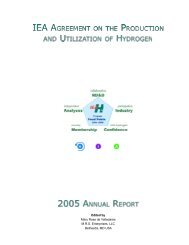Technology Status of Hydrogen Road Vehicles
Technology Status of Hydrogen Road Vehicles
Technology Status of Hydrogen Road Vehicles
You also want an ePaper? Increase the reach of your titles
YUMPU automatically turns print PDFs into web optimized ePapers that Google loves.
difficulties must be overcome:<br />
! High capital cost, probably subject to steep economies <strong>of</strong> production, but saddled with precious catalysts<br />
both scarce and expensive.<br />
! Low current densities at electrodes, increasing bulk and weight, decreasing useful load and decreasing<br />
vehicle efficiency at the wheels.<br />
! <strong>Hydrogen</strong> storage.<br />
Although these drawbacks make FCs impractical for industrial use today, the space applications (the Shuttle<br />
has three 12-kW FCs) and increasing transport demonstrations (see Tables 1 and 2) are putting them in better<br />
perspective: the potential economies <strong>of</strong> future mass production are undeniable, and Pt loadings at the<br />
electrodes have decreased by one to two orders <strong>of</strong> magnitude in the past 10 years; current densities are<br />
increasing rapidly, and have improved threefold in recent years; while hydrogen storage can be roughly half<br />
that <strong>of</strong> ICE vehicles with the same range, and significant progress is being made as discussed in Chapter 3.<br />
If we compare this perspective with that <strong>of</strong> the ICE at a similar stage in its development--say 100 years ago-there<br />
is every reason to be optimistic about FC development, provided it receives the concentrated industrial<br />
attention that the ICE enjoyed. This being said, one item could halt the large-scale deployment <strong>of</strong> FCs: their<br />
use <strong>of</strong> strategic and scarce catalysts. If the relative loadings cannot be brought to acceptable levels, not only<br />
the price but ultimately the unavailability <strong>of</strong> the present favorites (Pt, Pd, etc.) could be decisive.<br />
A3.2 Types <strong>of</strong> Fuel Cells<br />
The main distinguishing feature <strong>of</strong> FCs is the type <strong>of</strong> electrolyte.<br />
Ideally, the electrolyte should allow easy passage <strong>of</strong> the hydrogen ions without allowing electrons through.<br />
At the moderate temperatures preferred for transport applications, a strong acid or strong alkali solution is<br />
indicated and led to earlier choices <strong>of</strong> phosphoric acid or potassium hydroxide alkali as electrolytes. Known<br />
respectively as PA FC and A FC, they have found some limited application. However, the actual experience<br />
has not been favorable and they are being abandoned for what is becoming the almost unique choice: an acidtype<br />
in the form <strong>of</strong> a solid polymer known then as a SPE FC, but now increasingly called the PEM FC.<br />
The solid polymer electrolyte <strong>of</strong> the PEM FC comes in very thin sheets (only a few tenths <strong>of</strong> a micron) and,<br />
although it must be kept humid, it is not subject to liquid loss. The sheets are under proprietary trademarks<br />
or patents, are very expensive considering the bulk plastics industry behind them, and are presently marketed<br />
by Asahi, Ballard, De Nora, Dow, DuPont and probably others. Since only these thin sheets and relative<br />
humidity paths separate the electrodes, the stacking density (cells/cm) is relatively high but a limit is posed<br />
by the electrode thickness which demands inversely-proportional catalyst loading. The current density (A/cm 2 )<br />
<strong>of</strong> these sheets is relatively high, and appears to be increasing rapidly. The result is -and the evolution is<br />
strongly in favor <strong>of</strong> the PEM FC- that it provides power densities (W/kg) over 260, as compared to about 100<br />
for PA FC or 65 for A FC, all at efficiencies <strong>of</strong> 50%-55%.<br />
Nonaqueous electrolytes are also being developed for FCs, the most important being molten carbonates, which<br />
operate at 650°C, and solid oxides, which operate at 1000°C. The high temperatures encourage the<br />
electrochemical reactions, and catalysts can be dispensed with, but other problems can arise on road vehicles<br />
and, so far, no project has emerged. Considerable interest is shown in these high-temperature FCs for<br />
stationary power generation.<br />
Attention will be restricted in the following to the PEM FC, but much will be applicable to others, especially<br />
the aqueous low-temperature ones.<br />
A3.3 FC System Optimization<br />
38













